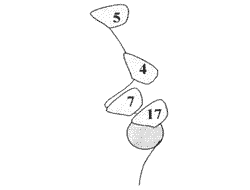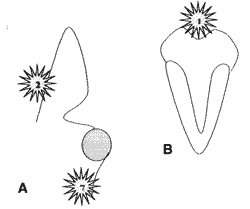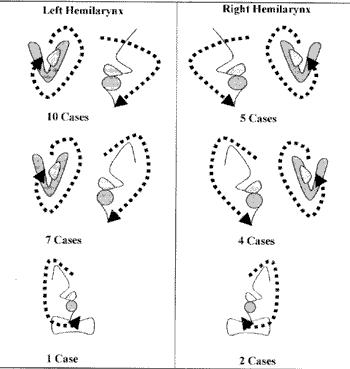INTRODUCTIONAfter more than a century of trials and errors, medicine has come to the point of wondering what is the best intervention for management of laryngeal tumors: radical surgeries without preservation of organ or procedures that have the same curative potential but with the possibility of preserving the organ.
Among all types of head and neck squamous cell carcinomas, laryngeal cancer is undoubtedly the one that has the best oncologic results, regardless of the therapeutic modality.
After reaching 80% five-year survival, a milestone from the 70's, we have not succeeded,in improving the statistics in the next 30 years. This fact, associated with the wide variability of individual response, in which some patients have discouraging; results, whereas most progress to cure, make us wonder if the current approach has come to a plateau from an oncologic viewpoint. On the other hand, we have noticed a growing number of indications of more conservative treatment approaches for management of tumors.
We believe that the current trend towards organ preservation using concomitant chemotherapy and radiotherapy is a promising path, but we also notice that there is room for more daring partial surgeries.
As far as laryngeal tumors, T3 tumors are considered the limit for conservative approaches, and only in a few centers partial surgeries are performed.
At Santa Casa de São Paulo we have managed patients with advanced laryngeal cancer that presented cervical clinical N0 neck. This kind of case seemed to require a more conservative approach. The present study intended to assess the oncologic and functional outcomes of laryngeal conservative surgery in laryngeal T3 and T4 tumor patients.
MATERIAL AND METHODWe assessed 29 patients operated on from 1990 to 1997 and followed up to year 2000. The ages ranged from 16 to 82 years (mean age of 65 years). There were three women in the group, mean age of 67 years. The mean follow-up was 5.3 years, and six patients (20.6%) were followed up for only 3 years.
As to tumors, 17 were centered on the vocal fold; seven were in the laryngeal ventricle; four were on the vestibular fold, and five were on the aryepiglottic fold. All of them presented vocal fold fixation. Seven of the tumors extended into the infraglottic region, two into the pyriform sinus, and one into the retrocricoarytenoid region. There were 14 T3 and 15 T4 tumors. They were all considered N0 neck before the surgery: however, three of them had positive lymph nodes in pretracheal region during the surgery and were submitted to modify radical neck dissection, wide-field type (bilateral cervical lymphadenectomy in two cases and unilateral procedure in one case, preserving jugular veins and spinal nerve). All patients were submitted to bilateral cervical field radiotherapy (45Gy) and 18 patients received adjuvant radiotherapy on the remaining larynx because they had compromised internal perichondrium (Figures 1 and 2).

Figure 1. Distribution of tumors by locating the center of lesion (coronal view of right hemilarynx).

Figure 2. Distribution of tumors by invasion of adjacent areas (A - saggital view; B - superior view).
Surgical treatment was based on location of the center of lesion and the main concern was to remove the tumor en bloc with safe margins; however, we did not consider traditional invasion limits of elastic cone, anterior commissure and pre-epiglottic space. The larynx was seen as an organ without compartments (from an oncologic prognostic viewpoint) and the tumor was resected with that concept bore in mind. The same principle has been applied by a number of European authors to perform laser endoscopic resections.
TABLE 1 - Distribution of type of resection by side.

Patients were evaluated after surgery and we considered daily activities, speaking and swallowing satisfaction and disease-free survival.
RESULTSThe surgeries performed were (Table 1):
Ten left vocal fold resections, from anterior commissure to arytenoid, plus association with left vestibular fold resection (partial) and membranous portion of right vocal fold.
Five right vocal fold resections, from the anterior commissure to arytenoid, plus association with right vestibular fold resection (partial) and membranous portion of left vocal fold.
Seven right aryepiglottic fold resections including right arytenoid, right vestibular fold, right vocal fold and anterior third of left vocal fold.
Four left aryepiglottic fold resections including left arytenoid, left vestibular fold, left vocal fold and anterior third of right vocal fold.
Two right aryepiglottic fold resections including right arytenoid, right vestibular fold, right vocal fold and anterior third of left vocal fold, with partial resection of right superior-lateral border of cricoid.
TABLE 2 - Distribution of patients according to day of tracheotomy tube removal.

TABLE 3 - Distribution of patients according to day of oral diet introduction.

One left aryepiglottic fold resection including left arytenoid, left vestibular fold, left vocal fold and anterior third of right vocal fold, with partial resection of left superior-lateral border of cricoid.
All resections included exeresis of thyroid cartilage lamina on the tumor side.
Reconstruction approaches were based on use of ipsilateral sternohyoid muscle and remaining supraglottic mucosa, used to recover the laryngeal defect and the contralateral sternohyoid muscle to reconstruct the anterior portion of the glottis.
As to post-operative data, the observations are presented in Tables 2 to 10.
DISCUSSIONAfter the analysis of the ten-year experience with partial resection of advanced tumors of the three laryngeal segments, we observed that we had an excellent postoperative period. The mean days with cannulation was about 5.7, and the mean days with nasogastric tube was 5.7, and only one patient required permanent use of tube (feeding purposes) and cannula, and another one maintained the cannula.
TABLE 4 - Distribution of patients according to degree of satisfaction of speaking status.

TABLE 5 - Distribution of patients according to respiratory status.

TABLE 6 - Distribution of patients according to swallowing status.

TABLE 7 - Distribution of patients by local recurrence.

TABLE 8 - Distribution of patients according to cervical recurrence.

TABLE 9 - Distribution of patients by salvage surgery.

Note: * 2 patients with T4 tumors and 1 with T3 tumor; ** 2 patients considered T3 in the first surgery; *** patient T3 and N0 in the first surgery.
TABLE 10 - Distribution of patients by post-salvage tumor control.

Note: * 1 patient T3 after total laryngectomy and 1 patient T3I after radical neck dissection.
Opinions of patients about speaking and respiratory status after surgery were favorable in 89% of the cases and swallowing conditions were considered favorable in 97% of the cases.
About 83% of the patients achieved three-year disease-free survival and about 62% achieved five-year disease-free survival.
The findings were very similar to what was reported for conservative surgery of initial T1 and T2 laryngeal tumors1,2,4,9,19,20,22.
Salvage surgery was performed in five occasions and in two of them it was possible to conduct a new partial resection. Both cases have not developed recurrence so far (13 months and 21 months after the second resection, respectively), a fact that had been described by other authors1,12,22.
We understand that cure for advanced laryngeal squamous cell carcinoma is more difficult to be obtained than for initial cases, and we also believe that the years we spent indicating surgeries that did not preserve the organ have served as substantial teaching material for the area of head and neck surgery. However, time has shown that we have advanced very little in terms of five-year survival, regardless of the kind of therapy used4,8,10,11,13,14,15,17. On the other hand, we observed that the surgery for initial tumors has gradually reduced its aggressiveness. The advent of laser has favored more freedom to resect larger tumors, which has served as a motivation to perform an increasing number of partial surgeries with organ preservation4,5,8. The present retrospective study shows that it is possible to provide tumor control with preservation of organ without compromising the survival.
The sample described here referred to associated adjuvant radiotherapy for tumor site and it was exclusive for treatment of cervical fields. However, the continuous study of combined therapeutic modalities, such as partial pre or post-surgical concomitant chemoradiotherapy may produce very successful results14,18.
CONCLUSION• Tumor staging is not necessarily a limitation for conservative laryngeal surgery.
• Association of conservative surgery and postoperative radiotherapy does not compromise three or five-year survivals.
• Post-operative speaking, respiration and swallowing status was satisfactory in more than 89% of the cases.
REFERENCES1. BIACABE, B; CREVIER, L; LACCOUREYE, O. BRASNU, D. - Vertical partial laryngectomy with false cord flap reconstruction: carcinologic and functional results. Ann. Otolaryngol. Chir Cervicofac., 115(4): 89-95, 1998.
2. BIACABE, B; HANS, S; LACCOURREYE, O, BRASNU, D. - Vocal function after vertical partial laryngectomy with glottic reconstruction by false vocal fold flap: duration and frequency measures. Laryngoscope, 109(5): 698-701, 1999.
3. BOCKLER, R; BONKOWSKY, V; SEIDLER, T; HACKI, T Comparative voice quality evaluation after laser surgical versus fronto-lateral partial laryngectomy in T1b and T2 vocal cord carcinoma. Laryngorhinootologie, 78(9): 5125, 1999.
4. BOLOT, G; POUPART, M; PIGNAT, J. - Reconstrutive subtotal laryngectomy: a personal technique in a series of 100 patients operated on between 1990 and 1997. Rev. Laryngol. Otol. Rhinol. (Bord), 120(2): 93-6, 1999.
5. DECLERQ, A; HAUWE, L; MARCK, E; HEYNING, P; SPANOGHE, M; SCHEPPER, A. - Patterns of framework invasion in patients with laryngeal cancer: correlations of in vitro magnetic resonance imaging and pathologic findings. Arch. Otolaryngol, 118(6): 892-5, 1998.
6. HUANG, Z; ZHANG, F, JIA, Z. - The usage of allograf nasal septal cartilage in partial laryngectomy. Lin Chuang Erh Pi Yen Hou Tsa Chih, 11(10): 449-5-, 1997.
7. JAWOROWSKA, E. - Horizontal laryngectomy in treatment of laryngeal cancer: oncologic and function results. Ann. Acad. Med. Stetin., 44: 175-95, 1998.
8. JIA, S; SUN; B; SHANG; L. - Extended vertical partial laryngectomy for treatment of the glottic cancer wit T3 category. Lin Chuang Erh Pi Yen Hou Tsa Chih, 31(6): 3657, 1996.
9. KOSZTYLA, B; CHODDYNICHKI, S; MIKIEL, W - Voice function in patients after partial laryngectomy. Otolaryngol. Pol., 52(4): 435-9, 1998.
10. LACCOUREYE, O; LACCOUREYE, L; MUSCATELLO, L; PERIE, S; WEINSTEIN, G; BRASNU, D. - Local failure after supracricoid partial laryngectomy: symptoms, management and outcome. Laryngoscope, 108(3): 339-44, 1998.
11. LACCOURREYE, O; DIAZ, E; BASSOT, V; MUSCATELLO, L; GARCIA, D; BRASNU, D. - A multimodal strategy for treatment of patients with T2 invasive squamous cell carcinoma of the glottis. Cancer, 85(1): 40-6, 1999.
12. LACOURREYE, O; GARCIA, D; HANS, S; MENARD, M. - Local recurrence after vertical partial laryngectomy, a conservative modality of treatment for patients with stage I-II squamous cell carcinoma of the glottis. Cancer, 85(12): 2549-56, 1999.
13. MENDENHALL, W; MILLION, R; STRINGER, S; CASSISI, N. - Squamous cell carcinoma of the glottic larynx: a review emphasizing the University of Florida philosophy. South. Med. J, 92(4): 385-93, 1999.
14. NISHIOKA, T; SHIRATO, H; FUKUDA, S. - A phase II study of concomitant chemotherapy for laryngeal carcinoma using carboplastin. Oncology, 56(1): 36-42, 1999.
15. PERSKY, M; DAMIANO, A. - Corniculate-cuneiform flap for reconstruction in the extended vertical partial laryngectomy. Ann. Otol. Laryngol., 107(4): 297-300, 1998.
16. PINILLA M; GONZALEZ, F; GORRIZ, C; ARELIANO, B; VICENTE, J; TRINDAD, A. - Oncologic surgery of he larynx after failure of radiotherapy. Arch. Otolaryngol. Esp., 49(8): 633'6, 1998.
17. RODRIGUEEZ, S; LABASTIDA, S; GONSALEZ, D; BRISENO, N; CORTES, H. - Partial laryngectomy as salvage surgery for radiation failures in T1 T2 laryngeal cancer. Head Neck, 20(7): 630-3, 1998.
18. ROSIER, J; GREGOIRE, V; COUNOY, H; ROMBAUNT, E - Comparison of external radiotherapy, laser microsurgery and partial laryngectomy for the treatment of T1N0M0 glottic carcinomas: a retrospective evaluation. Radiother Oncot, 48(2): 175-83, 1998.
19. SCOLA, B; FERNANDEZ VEJA, M; MARINEZ, T; SCOLA, E; FERNADEZ VEJA, S; RAMIRESZ, C. - The Gregorio Maranon Hospital experience with vertical partial laryngectomies. Eur Arch. Otolaryngol, 256(6): 296-8, 1999.
20. SHEEN, T; KO, J; CHANG, Y - Partial vertical laryngectomy in the treatment of early glottic cancer. Ann. Otol. Rhinol. Laryngol., 107(7): 593-7, 1998.
21. VAN AS, C; TIGGES, M; WITTENBERG, T - High-speed digital imaging of neoglottic vibration after total laryngectomy. Arch. Otolaryngol. Head Neck Surg., 125(8): 891-7 1999.
22. VICENTIIS, M; MINNI, A; GALLO, A; NARDO, A. Supracricoid laryngectomies: oncologic and functional results. Head Neck, 20(6): 504-9, 1998.
* Joint Professor and Head of the Division of Laryngology, Department of Otorhinolaryngology, Santa Casa de São Paulo.
** Professor of the Department of Otorhinolaryngology, Santa Casa de São Paulo.
*** Professor of the Department of Otorhinolaryngology, Santa Casa de São Paulo.
**** Teaching Preceptor of the Department of Otorhinolaryngology, HSPE-SP
***** Resident in Otorhinolaryngology, Santa Casa de São Paulo.
Address correspondence to: Rua Polônia 442 - 01447-000, São Paulo /SP
Article submitted on November 9, 2000. Article accepted on February 8, 2001.


